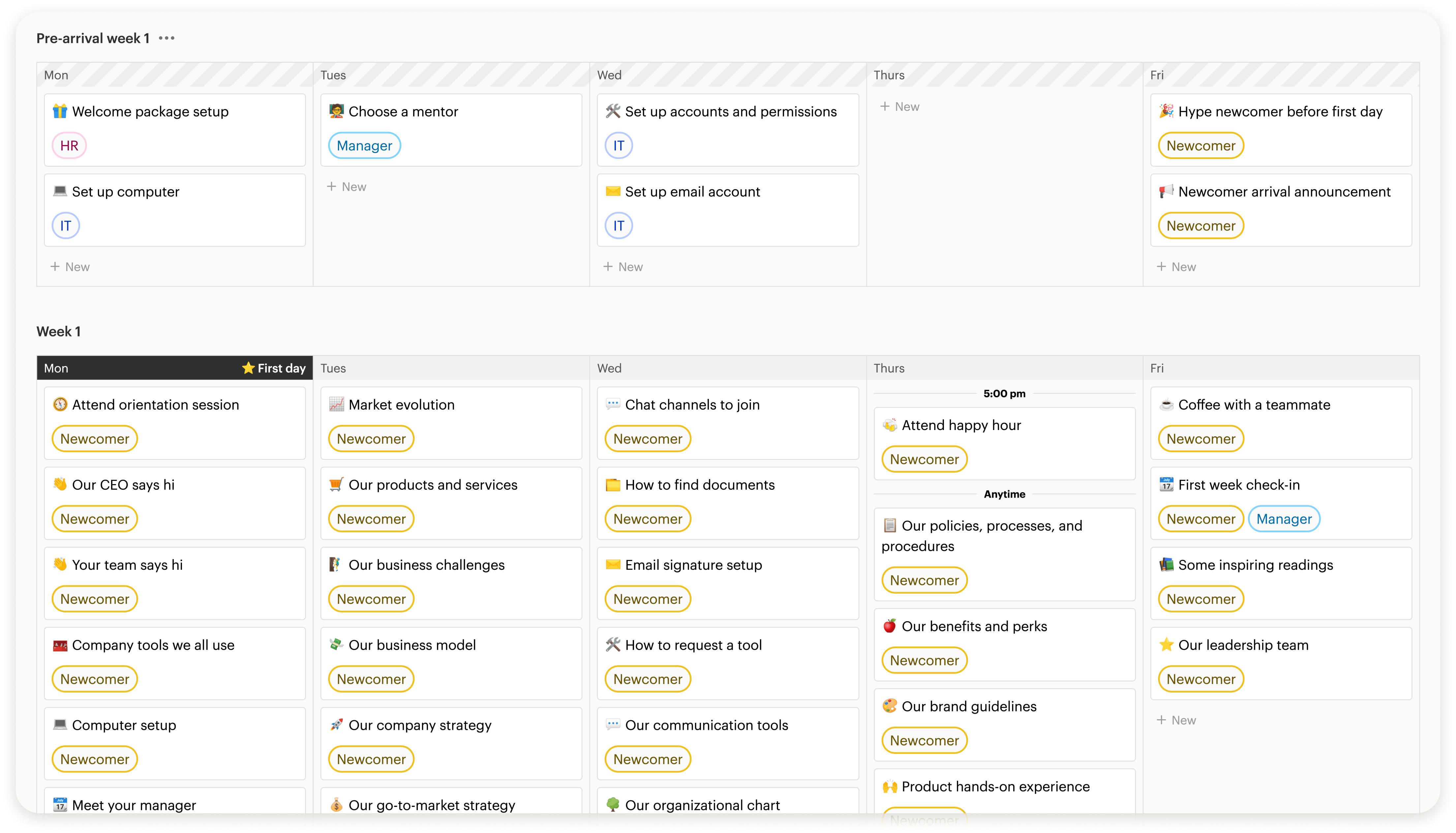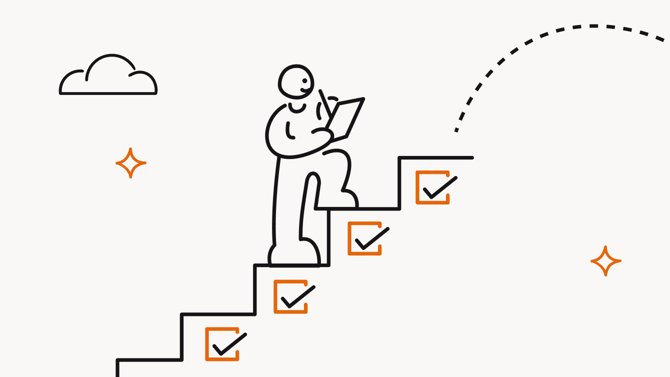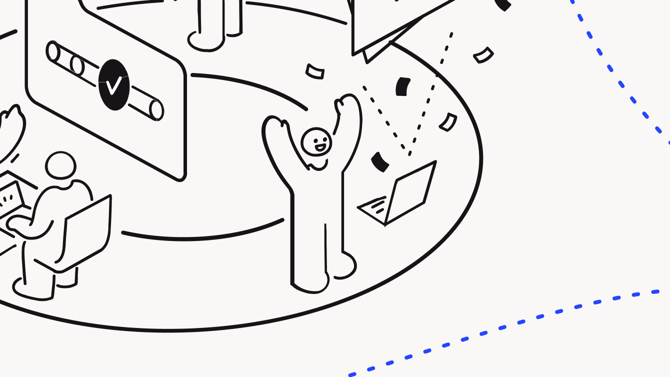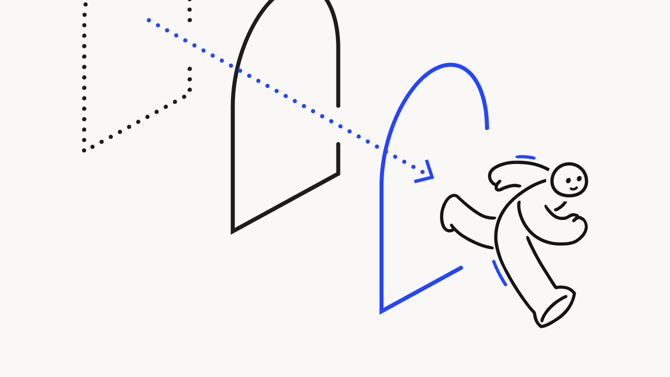Starting a new job is never easy, but there are things employers can do to make or break an experience. And when we say “things”, we’re not talking about providing free cupcakes to all of your new hires.
Not only does the reality of remote work make the delivery of treats logistically difficult, but as hiring becomes more competitive job-seekers have less of an appetite (pun intended) for symbolic gestures. Instead, they’re looking for an authentic, welcoming experience that not only prepares them for their next career step but offers full integration into a new company—an experience that is inherently intimidating.
Exclusive online summit
·
May 23 2024
Moments that matter: how to seed great work
What's in this article
If you’ve landed here because you’re looking to improve your onboarding experience, then welcome. You’ve come to the right place. Sadly, we don’t have any cupcakes to offer you. But we do have something even better—a new hire onboarding template (you can find it here).
Why New Hire Onboarding is Important
Onboarding sets the tone for new employees. It determines how likely they are to have a successful experience within your organization, including how long they plan to stick around.
Did you know? Research shows that organizations with a great onboarding process improve employee retention by a whopping 82%.
Companies with strong onboarding processes improve employee retention by 82%
As an HR who was once a new hire yourself, you know firsthand how important of a role you play in creating a positive and effective journey from day one.
Think back to the last time that you started a new job. Chances are that you left each work day feeling exhausted and overstimulated, overwhelmed by the new faces that you’ve yet to memorize and willing to let your brain turn into a sponge if it only meant you could soak up information faster.
Fortunately for us, there’s no need for our brains to give up their soft tissue state. Like so much in the world of business ops, your onboarding process is really what you make it. There is nothing that says that it has to be boring, repetitive, and confusing. You too can join the ranks of people-focused companies that are choosing to demystify the most important week (or weeks) in every new hire’s employment journey.
What Makes a Successful Onboarding Experience?
If you were to wrangle every great onboarding experience and put them in a room together, you’d notice that they all:
- Put people first: processes are an important part of learning a new job, but what really makes people feel like they belong is a warm welcome from their colleagues.
- Are engaging: there is no reason why, in 2022, we should allow onboarding experiences to be a total snoozefest. There is no shortage of fun activities that you can do with your existing team and new hire(s), including creative activities that are perfect for Zoom. “Powerpoint roulette” is always an instant hit—it’s where a volunteer has three minutes to give an ad-lib presentation to go along with random images on powerpoint slides. It’s way more hilarious than it sounds.
- Offer a centralized database: just because most of us spend our work days with 20 tabs open at once (*cough* guilty of this one), it doesn’t mean that we like to jump through hoops to access onboarding materials. It’s best if they’re all in one spot.
- Are structured: if the hiring manager seems lost, it doesn’t exactly inspire confidence in the newcomer. You can make sure everyone is invested in the success of the new hire by involving them in the process early on.
- Are empathetic: starting a new job is hard. The best onboarding processes put themselves in the new hire’s shoes and offer a pace that’s conducive to success. It also doesn’t hurt to ask for feedback along the way.
There are also certain components that go into determining the difference between a good and a great onboarding experience, namely:
Preboarding
The time between an employee accepting a job offer and having their first day on their job is a great opportunity to give a warm first impression by sending welcome emails and letting them know what to expect during the onboarding process.
It may be tempting to “protect” your new hire(s) by limiting them to introductions within their own department. But prolonging the inevitable intros will just lead to silo’ing. Employee onboarding is a team effort, from the IT department working hard at comparing computers and setting up software log-ins to team members to office managers (or community managers) noting dietary restrictions. It’s best to fully integrate your new team member from the get-go by giving them an overview of who’s who across the board.
Onboarding
You know the drill—onboarding acquaints your new hire with your team and company (and vice versa).
While the nitty gritty takes place during the fast few weeks, it may surprise you that onboarding doesn’t actually take a matter of weeks or even months. It takes years for an employee to fulfill their potential, which makes a solid foundation so important.
Training
Onboarding and training often overlap, but they’re not the same thing. While onboarding is about introducing employees to the team (including people and processes), training is more detailed and focuses on how to succeed at the technical aspects of a job.
Examples of a Successful Onboarding Experience
Sold on the idea of a successful onboarding experience and wondering who you can emulate? We’ve already compiled a selection of new employee onboarding examples that we think really hit the mark. Here are some takeaways that all of these examples share:
- They don’t hesitate to define roles and responsibilities—they make these clear from day one so new hires (and their existing teammates) aren’t kept guessing
- They make use of some kind of “buddy” system that encourages interaction between new peers
- They welcome the role of feedback from day one, i.e., the ability to give feedback is open to all and doesn’t have to be “earned” with experience
- They each take a “big picture” view of the “why” and “how” of each company
- They leave room for humanity and don’t just focus on operations and processes
The onboarding process is not going to look the same at all companies. Part of this is because every company is going to have a different budget, approach, and culture. The other part is that you don’t want your onboarding process to look like every other company. You’ll want to take the best practices into consideration and add your own unique touch.
Sounds Great. How Do I Get Started?
Getting started is exactly what the Workleap Onboarding platform and its templates enable you to do. Let’s take a comprehensive look at how to use our new hire onboarding template.
How to use Workleap's New Employee Onboarding Template
Drag and Drop
When you work with Workleap Onboarding, there’s no need to learn a whole new software. If you know how to drag and drop, you know how to use our system including our new hire onboarding template.
Our proprietary platform makes it easy to drag and drop onboarding activities on a calendar view that’s viewable by both the onboarding manager and new employee. Embarking on a hiring spree? We make it easy to onboard employees in groups with bulk actions. Customize each activity for every newcomer.

Introduce
Speaking of newcomers, the onboarding template makes new employee introductions seamless. Through this portal, you can also set up a new employee onboarding checklist for your latest hire(s). This helps you both keep track of which i’s have been dotted and which t’s have been crossed.
Schedule
Unlike less sophisticated onboarding options that require you to manually set up calendar events, Workleap Onboarding lets you sync to Outlook and Google calendars directly from the platform. A total relief for remote companies working across multiple timezones. Never schedule an intro meeting while your coworkers in London or Rio are sleeping ever again!
Track Progress
We know you have a million and one things on your mind. Keep track of your new hire’s progress with a quick glance by tracking their progress on Onboarding. Plus, you can organize all of your resources in one place, so you don’t have to firehose your new hires with different links and platforms.
Customize
When incorporating a new platform, some companies worry about losing their unique branding. With Workleap Onboarding, you can customize each template so that it looks like it’s coming from you—what better way to get your new hires comfortable with your company’s overall image?
We’ve said it before and we’ll say it again—50% of HR leaders still use an Excel or Word document for their onboarding processes. Or worse, they use multiple programs, which turns the onboarding process into one great big game of telephone where there is no winner.
If we were to eliminate employee onboarding, there would be chaos. Onboarding doesn’t discard the concept—we just make it work for you.
Ready to see for yourself?



